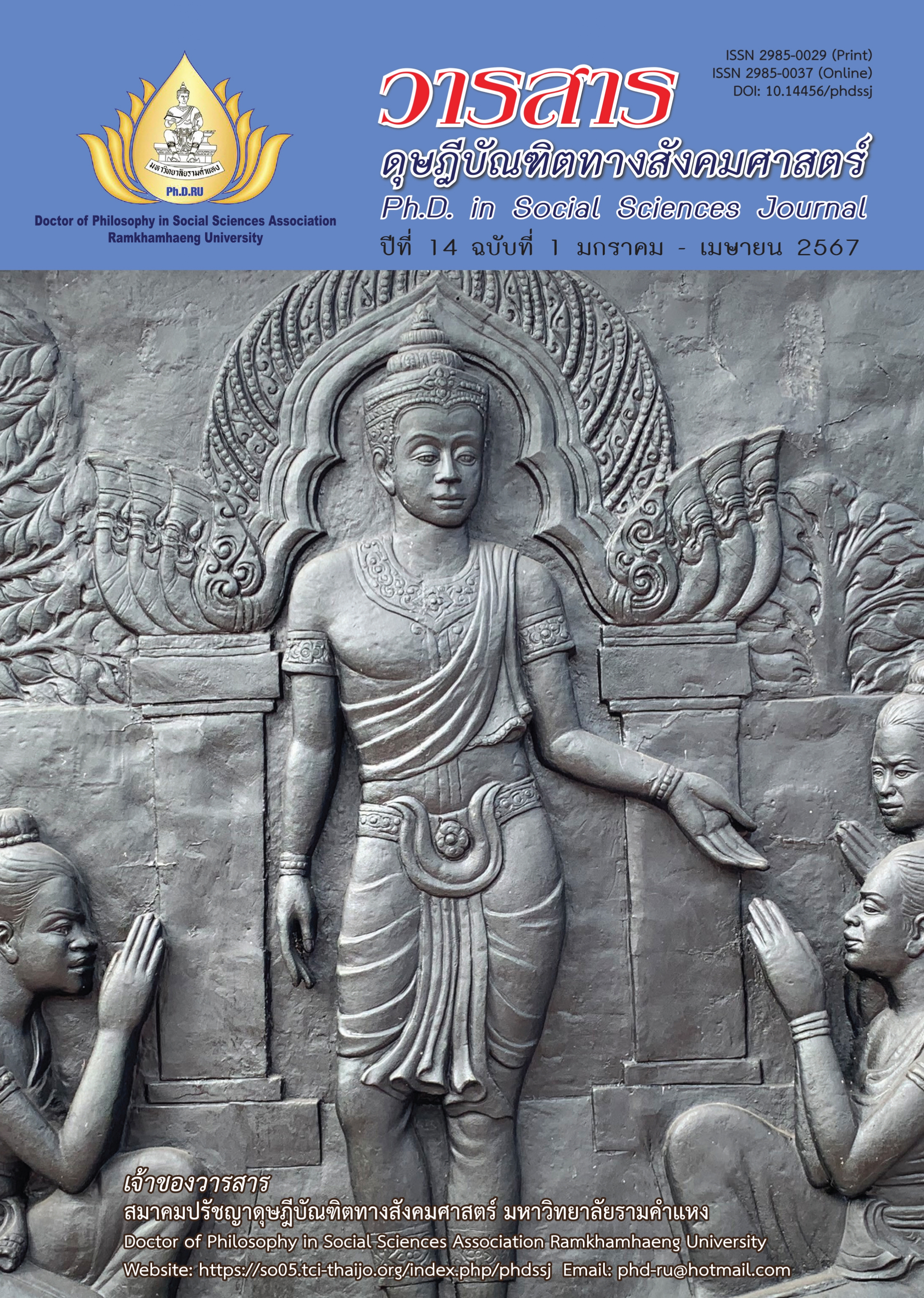โมเดลความสัมพันธ์เชิงโครงสร้างระหว่างคุณภาพพาณิชย์อิเล็กทรอนิกส์และความภักดีของผู้ซื้อสินค้าออนไลน์ โดยมีตัวแปรการรับรู้คุณค่าและความพึงพอใจเป็นตัวแปรส่งผ่าน
Main Article Content
บทคัดย่อ
บทความวิจัยนี้มีวัตถุประสงค์เพื่อ (1) ศึกษาปัจจัยคุณภาพระบบ คุณภาพการบริการอิเล็กทรอนิกส์ คุณภาพข้อมูลที่มีอิทธิพลต่อความภักดีของผู้ซื้อสินค้าออนไลน์ ผ่านการรับรู้คุณค่าและความพึงพอใจ และ (2) พัฒนาและตรวจสอบโมเดลความสัมพันธ์เชิงโครงสร้างระหว่างคุณภาพระบบ คุณภาพการบริการอิเล็กทรอนิกส์ คุณภาพข้อมูล ต่อความภักดีของผู้ซื้อสินค้าออนไลน์ ผ่านการรับรู้คุณค่าและความพึ่งพอใจ เป็นการวิจัยเชิงปริมาณ โดยใช้แบบสอบถามเป็นเครื่องมือในการเก็บรวบรวมข้อมูลจากกลุ่มตัวอย่างที่เป็นผู้ซื้อสินค้าออนไลน์ จำนวน 400 คน และใช้สถิติเชิงพรรณนา การวิเคราะห์องค์ประกอบเชิงยืนยัน และการวิเคราะห์โมเดลสมการโครงสร้างในการวิเคราะห์ข้อมูล
ผลการวิจัย พบว่า โมเดลสอดคล้องกับข้อมูลเชิงประจักษ์อยู่ในเกณฑ์ดี ค่าไคส์แควร์ (χ²) มีค่าเท่ากับ 150.329 ค่าชั้นแห่งความเป็นอิสระ (df) มีค่าเท่ากับ 133 ค่าไคสแควร์สัมพัทธ์ (χ²/df) มีค่าเท่ากับ 1.130 ค่าพี (p-value) มีค่าเท่ากับ 0.145 ค่าดัชนีรากของค่าเฉลี่ยกำลังสองของการประมาณค่าความคลาดเคลื่อน (RMSEA) มีค่าเท่ากับ .019 ค่าดัชนีวัดระดับความสอดคล้อง (GFI) มีค่าเท่ากับ .958 นอกจากนี้ ผลการวิจัยพบว่า (1) คุณภาพข้อมูลมีอิทธิพลทางบวกต่อการรับรู้คุณค่า (2) คุณภาพข้อมูลมีอิทธิพลทางบวกต่อความพึงพอใจ (3) ความพึงพอใจมีอิทธิพลทางบวกต่อความภักดี และ (4) คุณภาพข้อมูลมีอิทธิพลทางอ้อมต่อความภักดีของผู้ซื้อสินค้าออนไลน์ผ่านความพึงพอใจ
Article Details

อนุญาตภายใต้เงื่อนไข Creative Commons Attribution-NonCommercial-NoDerivatives 4.0 International License.
บทความวิชาการ บทความวิจัย และบทวิจารณ์หนังสือในวารสารดุษฎีบัณฑิตทางสังคมศาสตร์ เป็นความคิดเห็นของผู้เขียน มิใช่ของคณะผู้จัดทำ และมิใช่ความรับผิดชอบของสมาคมปรัชญาดุษฎีบัณฑิตทางสังคมศาสตร์ มหาวิทยาลัยรามคำแหง (กรณีการทำวิจัยในมนุษย์ ผู้วิจัยต้องผ่านการอบรมจริยธรรมการวิจัยในมนุษย์ และนำหลักฐานมาแสดง)
เอกสารอ้างอิง
Alam, S. S., & Yasin, N. M. (2010). An investigation into the antecedents of customer satisfaction of online shopping. Journal of Marketing Development and Competitiveness, 5(1), 71-78.
Arai, A., Ko, Y. J., & Ross, S. (2014). Branding athletes: Exploration and conceptualization of athlete brand image. Sport Management Review, 17(2), 97-106.
Bolar, K., & Shaw, B. (2015). End-user acceptance of online shopping sites in India. The Journal of Internet Banking and Commerce, 20(2), 1-18.
Burda, D., & Teuteberg, F. (2015). Understanding service quality and system quality success factors in cloud archiving from an end-user perspective. Information Systems Management, 32(4), 266-284.
Cetinsoz, B. C. (2015). The influence of e-service quality on customer perceived value: A study on domestics tourists in Turkey. International Journal of Science and Research, 4(1), 1265-1277.
Cabezudo, R. S. J., Izquierdo, C. C., & Pinto, J. R. (2013). The persuasion context and results in online opinion seeking: Effects of message and source-The moderating role of network managers. Cyberpsychology, Behavior, and Social Networking, 16(11), 828-835.
Chang, E., Hussain, F., & Dillon, T. (2006). Trust and reputation for service-oriented environments: Technologies for building business intelligence and consumer confidence. John Wiley & Sons.
Chen, J., & Dibb, S. (2010). Consumer trust in the online retail context: Exploring the antecedents and consequences. Psychology & Marketing, 27(4), 323-346.
Chen, M.-H., Tsai, K.-M., Hsu, Y.-C., & Lee, K.-Y. (2013). E-service quality impact on online customer’s perceived value and loyalty. China-USA Business Review, 12(5), 473-485.
Chen, X., Huang, Q., & Davison, R. M. (2017). The role of website quality and social capital in building buyers’ loyalty. International Journal of Information Management, 37(1), 1563-1574.
Davis, F. D. (1989). Perceived usefulness, perceived ease of use, and user acceptance of information technology. MIS Quarterly, 13(3), 319-340.
Dedeke, A. N. (2016). Travel web-site design: Information task-fit, service quality and purchase intention. Tourism Management, 54, 541-554.
Delone, W. H., & McLean, E. R. (2003). The DeLone and McLean model of information systems success: A ten-year update. Journal of Management Information Systems, 19(4), 9-30.
Dlačić, J., Arslanagić, M., Kadić-Maglajlić, S., Marković, S., & Raspor, S. (2014). Exploring perceived service quality, perceived value, and repurchase intention in higher education using structural equation modelling. Total Quality Management & Business Excellence, 25(1–2), 141–157.
Ha, H. Y. (2012). The effects of online shopping attributes on satisfaction–purchase intention link: A longitudinal study. International Journal of Consumer Studies, 36(3), 327-334.
Hair, J. F., Black, W. C., Babin, B. J. and Anderson, R. E. (2010). Multivariate data analysis (7th ed.). Pearson.
Hsieh, M. T., & Tsao, W. C. (2014). Reducing perceived online shopping risk to enhance loyalty: A website quality perspective. Journal of Risk Research, 17(2), 241-261.
Hsu, L.-C., Wang, K.-Y., & Chih, W.-H. (2013). Effects of web site characteristics on customer loyalty in B2B e-commerce: Evidence from Taiwan. The Service Industries Journal, 33(11), 1026-1050.
Kincl, T., & Štrach, P. (2012). Measuring website quality: Asymmetric effect of user satisfaction. Behaviour & Information Technology, 31(7), 647-657.
Kumbhar, V. M. (2011). Factors affecting the customer satisfaction in e-banking: Some evidences form Indian banks. Management Research & Practice, 3(4), 1-14.
Likert, R. (1932). A technique for the measurement of attitudes. Archives of Psychology, 22, (140), 55.
Liu, C., Arnett, K. P., & Litecky, C. (2000). Design quality of websites for electronic commerce: Fortune 1000 webmasters’ evaluations. Electronic Markets, 10(2), 120-129.
Ministry of Digital Economy and Society. (2016). Digital development plan for economy and society. Retrived from https://www.mdes.go.th/content/download-detail/2798 [In Thai]
Parasuraman, A., Zeithaml, V. A., & Malhotra, A. (2005). ES-QUAL: A multiple-item scale for assessing electronic service quality. Journal of Service Research, 7(3), 213-233.
Pearson, A., Tadisina, S., & Griffin, C. (2012). The role of e-service quality and information quality in creating perceived value: Antecedents to web site loyalty. Information Systems Management, 29(3), 201-215.
Rababah, O., Al-Shboul, M., & Al-Sayyed, R. (2011). A new vision for evaluating the quality of e-commerce websites. International Journal of Advanced Corporate Learning (iJAC), 4(1), 32-41.
Roman, S. (2010). Relational consequences of perceived deception in online shopping: The moderating roles of type of product, consumer’s attitude toward the internet and consumer’s demographics. Journal of Business Ethics, 95(3), 373-391.
Santana, S., & Loureiro, S. (2010). Assessing benefits and risks of online shopping in Spain and Scotland. Portuguese Journal of Management Studies, 15(2), 161-172.
Shojaee, S., & Azman, A. B. (2013). An evaluation of factors affecting brand awareness in the context of social media in Malaysia. Asian Social Science, 9(17), 72-78.
Visinescu, L. L., Sidorova, A., Jones, M. C., & Prybutok, V. R. (2015). The influence of website dimensionality on customer experiences, perceptions and behavioral intentions: An exploration of 2D vs. 3D web design. Information & Management, 52(1), 1-17.
Wang, W.-T., & Lu, C.-C. (2014). Determinants of success for online insurance web sites: The contributions from system characteristics, product complexity, and trust. Journal of Organizational Computing and Electronic Commerce, 24(1), 1-35.
Wiedmann, K. P., Hennigs, N., Pankalla, L., Kassubek, M., Seegebarth, B., & Reeh, M. O. (2010). Online distribution of pharmaceuticals: Investigating relations of consumers’ value perception, online shopping attitudes and behaviour in an e-pharmacy context. Journal of Customer Behaviour, 9(2), 175-199.


